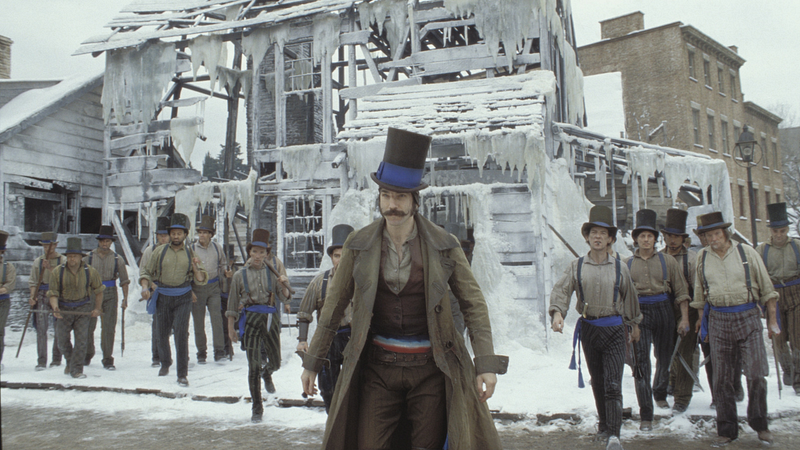
Constructing and inhabiting narrative worlds, in films and games
Ed. This piece was originally published at cityofsound.com on 7 January 2003.
“Imaginative and wholly unbelievable, seems too big for any screen it could possibly be projected onto; it spills and sprawls off the margins, and you can imagine whole panoramic worlds outside the frame, worlds in which extras hired at union wages walk down cobbled streets, pick some pockets, toss back a few drinks — invisible symbols of the movie’s commitment to absolute authenticity. But at some point you have to stop building a world and start telling a story, and in Gangs of New York, Scorsese is so distracted and dazzled by his homemade universe he just can’t seem to hunker down.”—Gangs Of New York, in Salon
Well, why would he? He’s happier “building a world”, and to be honest, I’d be quite happy to pay a fiver just to experience the version of New York that Scorcese et al created. Here, I couldn’t give a fig about narrative, characterisation etc. I’d go and pay to sweep a virtual camera around the painstakingly envisioned sets, swooping in and out of the bustling 1850s street scenes, pulling back to count the ships jostling in a Hudson teeming with steel-hulled traffic, panning across into The Five Points …
In a recent Sight & Sound, Scorcese gives an impression of their world-building antics:
Ian Christie: “(T)he vast set must have been an inspiration. It’s the most substantial, lived-in set I’ve seen.”
Martin Scorcese: “We built it, full scale and detailed, so we could move around outside and improvise. It was fantastic.”
Sight & Sound, Jan 2003, Volume 13, Issue 1
I feel I want to spend a bit more time around that set. All that work, for just a couple of hours in a cinema, with someone else driving.
I’m not suggesting that wordless camera-movement is antithetical to narrative. Anthony Lane’s fantastic New Yorker review of Scorcese’s The Age Of Innocence makes clear the reverse:
“The camera glides with all the stateliness of a Max Ophuls shot, then stops short as other images punch in: the conductor glimpsed through a haze of footlights, the auditorium viewed, from the stage, as a mass of silk and shirtfronts, then, from overhead, as an orderly parade. There is an extraordinary moment when its ranks begin to shudder; Scorcese is shaking his camera at them as though it were a fist, as though it were the artist’s duty to disturb the peace and poise of another age. This is Raging Bull in a china shop.”
—From Nobody’s Perfect, by Anthony Lane
As with other directors who’ve developed a true visual grammar in cinema, indeed as cinema, from Eisenstein, Vertov, Pudovkin, and Ruttmann to Bruce Conner, Saul Bass, and Wong Kar-Wei, Scorcese is a master of this. And of course, I’m not suggesting that simply enabling everyone to move through the set will necessarily mean that much. Or that everyone can move a camera like Scorcese or Thelma Schoonmaker can, in order to induce meaning, learning, communication via the movement through, and observation of, an imagined world.
But consider the recent discussions about world-creation in the context of the recent Grand Theft Auto or The Sims (just as others have discussed the Buffyverse, or have created worlds like Gameneverending). Once you get used to immersing yourself in virtual worlds that you’re somehow complicit in the construction of, it’s an increasingly attractive mode of experience. Sometimes you just want to experience a virtual city as a player/participant — to wander through it, moving the camera around, affecting it in small, subtle, but meaningful ways, making your mark — rather than let any trappings of linear-media get in the way.
Perhaps the equivalent of a Gangs Of New York expansion pack for SimCity or even Grand Theft Auto (Grand Theft Horse and Carriage?), making use of all that work creating a world in a medium implicitly designed for exploring and participating in worlds … Given the high start-up costs, and relative return of films compared to video games, Miramax would probably recoup their $120m that way too. Current movie tie-in games concentrate on the action rather than the context. Either way, as game-like ‘world’, or historical tool, or both, imagine experiencing a multi-layered version of Scorcese’s various New Yorks.
It strikes me that I haven’t mentioned Grand Theft Auto: Vice City. It is, of course, as brilliant as suspected. It’s bigger, better; beautifully-rendered, with a cleverly open narrative structure, and the smartest integration of sound and music ever heard in a game. It certainly enables the ‘sheer joy of just being there’ I’m talking about above. But perhaps it isn’t the paradigm shift GTA3 was. The next level is surely a shared-city, networked version, open to constantly updated live content, new challenges and real people.
Ed. This piece was originally published at cityofsound.com on 7 January 2003.

Leave a comment